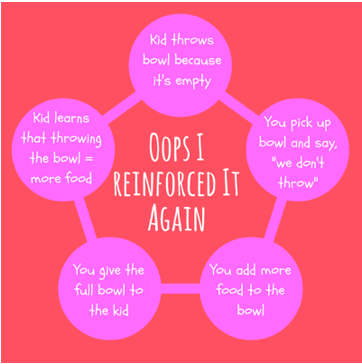Key points:
- Children respond more to actions than words; what you do matters most.
- Reinforcing positive behaviors is crucial to change unwanted behaviors effectively.
- Instead of giving in to unwanted behavior, encourage and model the desired behavior.
- Consistency and patience are key when changing the way children respond to limits and boundaries.

We all do it on a daily basis –we accidentally reinforce behaviors that we don’t like. The good news is that it is not too late to do something about it! With our little ones, especially those under 5 years of age, actions really do speak louder than words. Your child will respond to what you do 1000 times more than what you say (*see graphic above). So yes, you may say “we don’t throw”, but those words mean nothing if your actions don’t correspond. If your child’s unwanted behavior was effective in getting their needs met, then it will continue. So, in the example above, instead of throwing the bowl to get more food, they should pass you the bowl, say “more” or point to the wanted food, for example. We should not refill the bowl, until the child imitates the new, positive behavior that we model.
Let’s take a look at some real-life examples.
The Whine & Faux-Cry Combo
Your child whines or faux-cries in order to get an item that they want. You explain “That hurts my ears” or “You can use a big child voice”. But, if you give your child that wanted item after the whining or faux-crying, then they learn that it’s a great way to get things. Instead, you want to have your little one repeat the request with a “big child voice” and then give the item.
Grabbing Hands
Your child snatches things out of other people’s hands. You say, “That was not nice” or “We take turns”. However, if your child gets to keep the item that they snatched, then grabbing hands worked. Instead, have them return the item and then ask for it so that they can have a turn.
The “No” Backlash
Your child yells, screams, or throws things after you set a limit. Setting a limit could be anything from saying “It’s time to clean up” to responding “No” to a request. If your child displays significant backlash and you agree to negotiate the terms of the limit you just set, then, unfortunately, their negative behavior worked. Instead, be firm when establishing limits and provide your little one with two other choices that you feel comfortable with. For example, you may say “Mommy said no cookie. You can have an apple or crackers, you pick”.
The Bottom Line…
No matter what the unwanted behavior is, it is important to focus on changing the action, so that we reinforce positive behaviors instead. It is wonderful to use simple, encouraging language as well, but the actions are what matter most here. This is especially true if your child is in a heightened emotional state, since it is very hard to process language during these times.
The goal is to have your child do something else and then reinforce that behavior. You will need to demonstrate the new, preferred behavior and have your little one imitate you, so that you can properly reinforce the good stuff. You are changing the game on your tiny one, so it’s important to model first, repeat, and go slowly, so that they have time to adjust to the new rules. The key is to remain consistent and mindful so that you continue to reinforce the new positive behaviors instead of the reactive, unwanted behaviors.









One Response
What a useful article! It’s so easy to think that you’ve explained what you want so they must understand, I will really start thinking about my actions from now on!